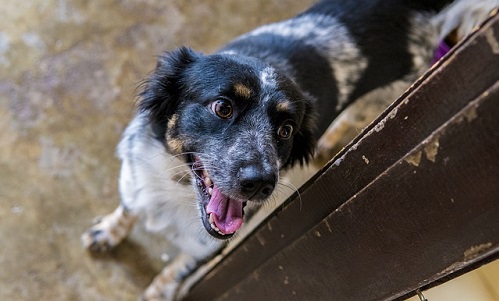Dogs are naturally curious creatures and tend to always be looking for something tasty to eat. Because of this constant desire to explore their surroundings with their mouths, our pets run the risk of unknowingly ingesting something they probably shouldn’t have. One of the scariest situations for a dog owner to imagine is coming home to find food or candy wrappers strewn across the house. Fear and panic begin to sink in as you look for the furry culprit who is now licking his guilty lips. Depending on what it is that your dog got into, you might be in the clear, but if gum wrappers are what you happened to find, then you could be in for a much more dire situation.
Sugar Free Gum
If you are a regular gum chewer, then you don’t need to worry much if you come home to find your dog smacking his lips on chewing gum. The gum will eventually pass through your dog’s system without any issues. The problem, however, comes with sugar-free gum. Most chewing gum brands use an artificial sweetener called “xylitol” in their sugar-free gum to give it that sweet taste without the calories. While xylitol is safe for you to consume, unfortunately, even the smallest amount can be deadly to dogs.
The reason being is that the human body can naturally tell the difference between real sugar and xylitol so when xylitol enters our system, it doesn’t release any extra insulin. However, a dog’s body doesn’t recognize the difference between the two. When a dog consumes xylitol, their body assumes that it is sugar and starts to release large amounts of insulin in order to process the sugar. But since xylitol isn’t actually sugar, the insulin can’t do anything to it. This means that all of this extra insulin just starts working on whatever sugar is there and breaking it down at a very rapid pace. This will cause your dog’s blood sugar levels to drop rapidly. When their blood sugar drops too low, a condition known as hypoglycemia sets in, which can lead to symptoms of shock and end up wreaking major havoc on your dog’s entire body.
There are other artificial sweeteners out there used in sugar-free gum besides xylitol, including mannitol, sorbitol, and aspartame that fortunately are not toxic to dogs. Just like xylitol, these sweeteners are considered “sugar alcohols” but don’t come with all of the harmful effects. There really is no reason to give any type of artificial sweetener to your dog in the first place, so you should avoid them altogether.
How Common Is Xylitol Poisoning in Dogs?
Not many dog owners are aware of the real dangers associated with sugarless gum and their pets. More and more cases of xylitol toxicity in dogs are reported every year due to the fact that there are more and more products containing this artificial sweetener appearing on the market. According to the ASPCA Poison Control Center, the number of dogs suffering from xylitol poisoning has greatly increased since the first reports in 2002.
How Much Xylitol Gum Is Toxic for a Dog?
 Typically, one piece of un-chewed gum with xylitol is enough to be considered a potentially toxic amount for a 10lb dog. It can be estimated that the average piece of gum or breath mint may contain anywhere from 0.22 to 1.0 grams of xylitol. This means that a 10lb dog would only need to eat one piece of sugarless gum to ingest a potentially toxic dose.
Typically, one piece of un-chewed gum with xylitol is enough to be considered a potentially toxic amount for a 10lb dog. It can be estimated that the average piece of gum or breath mint may contain anywhere from 0.22 to 1.0 grams of xylitol. This means that a 10lb dog would only need to eat one piece of sugarless gum to ingest a potentially toxic dose.
However, it can be hard to tell how much xylitol a dog has ingested because the xylitol content in sugarless gum may be difficult to determine. So this is best to be done by your vet. Make sure you keep the candy wrapper with the ingredient list handy when you call your vet and bring it along to the facility should your vet want to see your dog.
What If My Dog Ate Gum That’s Already Been Chewed?
Even if your dog is bigger than 10lbs and only ate a small amount for their size or the gum was previously chewed (most xylitol will have been removed), you may still want to consult with your vet to be safe, as they may tell you to monitor your dog for any symptoms of toxicity.
Xylitol Toxicity Symptoms
First things first: If your dog recently ingested gum with xylitol in it, stop reading now and contact your vet. Time is of the essence.
If your dog ingested sugar-less gum over half an hour ago, you should still report it to your vet immediately even if no symptoms are apparent. Your vet can provide supportive care to lower the chances of complications. The earlier you see the vet, the better the prognosis. Consider that symptoms may show up later. Fortunately, quick, supportive care will help a dog recover, but these stories don’t always have a happy ending.
If you come home and notice your dog acting especially unusual, check if any of their odd behavior matches the symptoms listed below. Symptoms of xylitol toxicity in dogs may arise within minutes but in some cases may be delayed, showing signs up to 72 hours after ingestion. For this reason, do not presume that your dog is out of the woods just because no symptoms arise right away. If your dog ate sugarless gum with xylitol, always consult with a veterinarian for directions on what to do and what to watch for. It is even better if you can get them to the vet before the symptoms start (but that is only possible if you catch your dog immediately after he ate gum.
The symptoms that you want to watch out for include:
- Loss of coordination
- Vomiting
- Fainting
- Seizures
- Liver failure
- Internal bleeding
The last two are not really something you can see just by looking at your dog but they are serious symptoms that could be fatal for your canine if not treated. So if you do notice any of the first four symptoms in your dog, there is a chance that they are also experiencing the last two as well.
The longer xylitol is in your dog’s system, the more damage it can cause. If left untreated for too long, it may even kill your dog. This is why it is so important to take your dog to the vet as soon as you notice these symptoms. When you’re on the phone with the Vet Tech, they will have a few specific questions to ask you related to the situation with your pet. Here are just a few questions to think about and expect to hear when making this important call:
- What type of gum did your dog ingest?
- What ingredients are in it?
- How long ago did your dog ingest the gum?
- How much gum did your dog eat?
- How much does your dog weigh?
- Is your dog showing any symptoms?
If an owner reports that their dog ate regular sugared bubble gum (not the sugarless type), then you most likely will not have to take them in. But, if your dog did eat a lot of gum, even the sugary kind, you can still expect some digestive upset to occur. And if your dog is on the smaller side, there’s potential for an obstruction to develop, especially if the outside layer of foil was ingested as well.
What to Do if Your Dog Ate Gum
- Determine the type of gum your dog ate. If it was sugary gum with no xylitol, your dog may develop digestive upset especially if they ate a large amount. Monitor your dog. Contact your vet if you notice any symptoms of a dog intestinal blockage.
- If the gum was sugar-free but didn’t have xylitol, only sorbitol, aspartame, or mannitol you should not see any ill effects.
- If your dog ingested sugarless gum over half an hour ago, report it to your vet immediately, even if no symptoms are showing. The earlier you see the vet, the better the prognosis.
If Your Vet Recommends Inducing Vomiting
If your dog ingested sugarless gum, your veterinarian may give you instructions on how to induce vomiting. If the ingestion happened a while ago, your vet may want to check your dog’s blood glucose levels. However, if your dog ingested sugarless gum within the last half hour, your vet may suggest that you induce vomiting at home using 3% hydrogen peroxide to minimize absorption. The quantity of hydrogen peroxide to give is based on your dog’s weight. If you’re unable to induce vomiting or don’t feel comfortable doing so, be sure to see your vet immediately. They can induce vomiting using other methods or can do a gastric lavage.
What to Expect at the Vet
When you get to the vet, you may be feeling panicked because you know this is a serious situation, but regardless of how overwhelmed you may be feeling, it is important to remain calm for the sake of both you and your animal. The danger of xylitol toxicity arises when it is left untreated, but with swift and proper treatment, your dog has a very high chance of survival.
If your vet recommends you bring your dog in right away and because this is an urgent problem, they will probably skip the diagnosis stage altogether and start treatment right away. The vet will then start monitoring the blood sugar levels in your dog and will make the appropriate adjustments as needed in order to stabilize your dog’s blood sugar. In many cases, the vet may even try to induce vomiting as a way to coax the gum out of their system. If it is not possible to get the xylitol gum out of their system this way, your little fur friend may need to be hospitalized for a period of time so that the vet can provide further care. This includes treatments such as administering IV fluids, liver protecting medication, as well as continuing to monitor and adjust their blood sugar levels. This process will continue until the gum fully passes through your dog’s system and they’re in safer state.
Other Treatments and Hospitalization
If your vet determines that inducing vomiting is not an option, they will need to monitor your dog’s levels of blood glucose. If the blood glucose is low, your dog will likely need dextrose administered intravenously to maintain normal glucose levels. Dogs are often hospitalized so the blood glucose can be monitored every two hours for at least 12 hours until the values return to normal.
 Liver values should also be monitored, but it’s important to consider that liver values may not change immediately because xylitol slowly inflames the liver. Liver enzymes are therefore expected to only go up usually after 48 hours after ingesting the gum. Your vet may also want to start supportive therapy for the liver depending on your dog’s condition.
Liver values should also be monitored, but it’s important to consider that liver values may not change immediately because xylitol slowly inflames the liver. Liver enzymes are therefore expected to only go up usually after 48 hours after ingesting the gum. Your vet may also want to start supportive therapy for the liver depending on your dog’s condition.
If your dog is prone to stealing food or gum, it is best to eliminate any products containing xylitol from your home. Keep sugarless candies and gums out of reach by storing them safely away, as you would for toddlers. Ultimately, you want to try to prevent this emotional and financial stress from happening again by being more careful about your gum. Either switch to a brand that does not have xylitol in it or make a strong effort to store it in places that your dog cannot reach. In the case of your pet’s life, it’s definitely better to be safe than sorry!
How to Contact Poison Control
It is a good practice to always keep the ASPCA’s poison control phone number handy for ingestion of toxins and poisons. They will give you instructions and a case number for follow-ups with your veterinarian. They are open 24/7 365 days a year. They can be reached toll-free at 888-426-4435.




